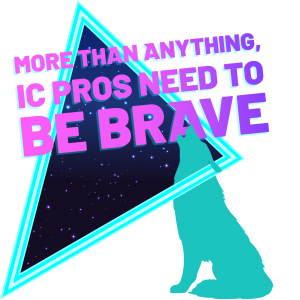How does internal comms (IC) remain relevant and relatable in the future?
1. Understand The Reflex
Our brains are wired to lead us to all sorts of easy and lazy biases, explained ICology’s Chuck Gose (Duran Duran superfan and sporting appropriate merch – shown in pic)
But how do these cognitive reflexes colour our world as communicators?
We can be blighted by information bias, where the amount of knowledge we are exposed to about our organisations can make it hard to clear the way to what people really need to know.
Our creativity can been killed by zero-risk bias, taking the easy way out and doing what we have always done.
But the biases can also prove useful – painfully underused in IC can be the humour bias, where tickling people’s funny bone can make them more amenable to the message or request.
Understanding and exploiting these reflexes can unlock powerful communications, so whhhhhyyyy don’t you use it?
2. Be Hungry Like the Wolf
More than anything, IC pros need to be brave, argued Jenni Field, the CIPR’s President Elect for 2019.
Only by maintaining the voice of IC at the top table and retaining the ear of leaders will the function be able to flourish and thrive.
That takes the guts to stand up and show leadership where IC can play an important strategic role in shaping an organisation or resolving issues. Not always easy, but earning respect and credibility is absolutely crucial to changing the conversation.
Leaders expect IC pros to understand it all, said Helen Schick, head of OD and engagement at the Alzheimer’s Society – the business, the people and everything going on in the outside world.
So learn how to summarise it back to them in a way they can easily process and understand:
- What they could gain or lose from a decision
- What you want them to do
- Why it is important
- Give them options
3. When you Come Undone
One of the most important ways IC is changing the conversation is on the topic of mental health.
A PRCA report released only last week revealed nine out of 10 comms pros have struggled with mental health at one time or another – an extraordinary and troubling stat.
The last few years has seen the taboo around the subject start to dissolve away and IC has helped lift the curtain by opening up the conversation in the workplace.
People like Jo Hooper, whose Mad and Sad Club is helping employers better understand mental health, are redefining how the issue is talked about – looking at the source of such problems in organisations, rather than sticking-plaster fixes.
IC’s role in this, working collaboratively across other areas such as HR and OD, is only likely to become more and more pivotal in the years to come.
As Jo explained, fear can stop people talking about mental health. IC can take control of that conversation.
4. IC’s Ordinary World
So where is IC in 2019? And where does it want its Ordinary World to be?
Rachel Miller, from All Things IC, described how IC needs to be about the HOW:
- Hearing – what are the internal conversations? The most important things are probably the most the things not being said, so what are the barriers to people talking openly?
- Outcomes – what do you want people to do/say/think/feel and as a result of your comms, how do you want them to behave? While measurement and evaluation are crucial, they are impossible without a clearly defined goal.
- Walking the walk – role modelling with good looks like and creating a shared language around internal communications, so your organisation’s mission seeps out into all areas.
Make these factors the norm and our ordinary world can translate into extraordinary comms.
5. The power of Girls (and boys) on Film
When it comes content, it doesn’t matter whether it’s externally or internally-focused – great content will always fly, said IC author and podcast host Katie Macaulay.
In fact, the external/internal divide is becoming nothing more than an artificial barrier to showing off the best of our organisations to the outside world.
This convergence means companies like Adidas allowing its sport-mad employees to blog their passion on the external website and Papa John’s using its franchisees to tell its story. Or Zurich providing free content to its employees to be social media advocates for the company.
Values and culture have becoming a marketing tool in their own right – internal comms as PR. Get the ‘why’ of your business right and the sales pitch to customers looks after itself.
Use the Patagonia test – could your mission statement double up as your marketing slogan?
By James Morton
@MortyJMo
















